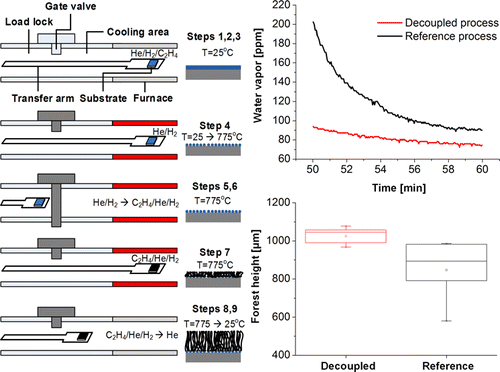
Year
2016Volume
120Issue
20Pages
11277–11287Abstract
Consistent synthesis of carbon nanotubes (CNTs) using laboratory-scale methods is essential to the development of commercial applications, particularly with respect to the verification of recipes that achieve control of CNT diameter, chirality, alignment, and density. Here, we report that, transients in the moisture level and carbon concentration during the chemical vapor deposition (CVD) process for vertically aligned CNT ‘forests’ can contribute significantly to run-to-run of height and density. Then, we show that highly consistent CNT forest growth can be achieved by physically decoupling catalyst annealing and hydrocarbon exposure steps, to allow the gas composition to stabilize between the steps. This decoupling is achieved using a magnetically actuated transfer arm to move the substrate rapidly into and out of the CVD reactor at desired steps of the process. Compared to a reference process where the sample resides in the furnace throughout the process, the decoupled method gives 21% greater CNT forest height, reduces the run-to-run variance of height by 76%, and results in forests with improved vertical alignment (Herman’s orientation parameter of 0.68 compared to 0.50). Building on this foundation, we study the influence of the moisture level during the CNT growth step, and find a 30% improvement in growth rate going from the baseline condition (<15 ppm) to 40 ppm. Interestingly however, the increased moisture concentration does not improve the catalyst lifetime or the CNT forest density, warranting further study of the role of moisture on CNT nucleation versus growth.






